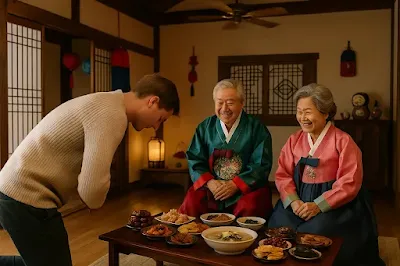Korean holidays like Seollal and Chuseok are more than just days off — they reflect Korea's seasonal traditions, family values, and food culture. Learn how each holiday is celebrated through the year.
Korea's four distinct seasons are filled with traditional holidays that reflect respect for nature, family, and ancestors.
While Seollal and Chuseok are the most well-known, there are many other seasonal holidays with unique foods and customs.
This guide is designed for international travelers and Korea-curious readers who want to better understand the traditions behind each season.
📅 What Is the Lunar Calendar in Korea?
Many Korean holidays are based on the lunar calendar, which follows the phases of the moon rather than the sun.
This means holiday dates change every year on the Gregorian calendar.
For example, Seollal usually falls in January or February, while Chuseok takes place in September or October.
Even locals check the calendar each year to confirm the exact dates!
❄️ Winter – Seollal (설날, Lunar New Year)
-
When: January or February (lunar calendar, 1st day of the year)
-
What it celebrates: Paying respect to ancestors and welcoming a new year with family.
-
Traditions: Ancestral memorials (Charye), New Year's bow (Sebae), wearing hanbok
-
Food: Tteokguk (rice cake soup)
-
Korean phrase:
👉 새해 복 많이 받으세요 (sae-hae bok ma-ni ba-deu-se-yo)
→ “Happy New Year!”
🌸 Spring – Hansik & Dano
🌿 Hansik (한식)
-
When: Early April (105 days after winter solstice)
-
Meaning: Visit ancestors’ graves and eat cold food to mark the beginning of the farming season
🌾 Dano (단오)
-
When: 5th day of the 5th lunar month
-
Customs: Herbal hair washing, traditional games like ssireum (wrestling) and swing rides
-
Food: Ssurichwi-tteok (mugwort rice cakes), Jehotang (herbal tea)
☀️ Summer – Sambok (삼복, Dog Days of Summer)
-
When: Between July and August (3 hottest days of the lunar calendar)
-
Purpose: Staying strong during the hottest time of the year with stamina-boosting food
-
Food: Samgyetang (ginseng chicken soup)
🍁 Autumn – Chuseok (추석, Korean Thanksgiving Day)
-
When: 15th day of the 8th lunar month (usually in September or October)
-
What it celebrates: Giving thanks for a successful harvest and honoring ancestors
-
Traditions: Charye (ancestral rites), family gatherings, traditional games
-
Food: Songpyeon (half-moon rice cakes), jeon (Korean pancakes)
-
Korean phrase:
👉 풍성한 한가위 되세요 (pung-seong-han han-ga-wi dae-se-yo)
→ “Have a bountiful Chuseok!”
🌬️ Winter – Dongji (동지, Winter Solstice)
-
When: December 21 or 22
-
Tradition: Eating red bean porridge (patjuk) to ward off evil spirits and welcome longer days
-
Korean phrase:
👉 동지 팥죽 드셨어요? (dong-ji pat-juk deu-syeot-seo-yo)
→ “Did you have red bean porridge on Dongji?”
🎎 What to Expect During Holiday Seasons in Korea
-
Heavy traffic nationwide as people visit their hometowns
-
Many restaurants and cafes close during Seollal and Chuseok
-
Traditional markets and folk villages become lively with festive energy
-
Public attractions may have limited hours — check in advance!
🙇 Korean Holiday Etiquette for Guests
Bowing (Sebae): A deep bow to elders is a respectful custom
-
Gifts: Fruit sets, health products, or traditional teas are safe options
-
Clothing: Avoid overly casual clothes; clean and modest is best. You may even be offered a hanbok to try!
🎉 Where to Experience Korean Traditions
-
Namsangol Hanok Village (Seoul): Try bowing, tteokguk, and traditional games
-
Korean Folk Village (Yongin): Watch traditional ceremonies and cook holiday food
-
National Folk Museum (Seoul): Great for family-friendly cultural programs
🍲 Regional Food Differences During Holidays
-
Seoul/Gyeonggi: Balanced and simple dishes
-
Jeolla Province: Rich flavors, lots of jeon and meat dishes
-
Gyeongsang Province: Spicier side dishes and seafood
-
Jeju Island: Use of seaweed, abalone, and mountain vegetables
👉 Many vegetarian options like namul (seasoned vegetables) and rice cakes are available, too!
🌀 How Korean Holidays Are Changing Today
-
Young people are skipping big family gatherings in favor of solo holidays or overseas trips
-
Pre-made holiday food kits and simplified ancestral rituals are becoming common
-
Families now do virtual bows and online greetings via video calls
💬 Final Thoughts
Korean holidays offer a deep look into the country's values — respect, community, and harmony with nature.
Even if you're visiting short-term or just learning the language, try saying:
-
“새해 복 많이 받으세요” (sae-hae bok ma-ni ba-deu-se-yo) during Seollal
-
“풍성한 한가위 되세요” (pung-seong-han han-ga-wi dae-se-yo) on Chuseok
Just a few words in Korean can bring smiles and start real conversations.


